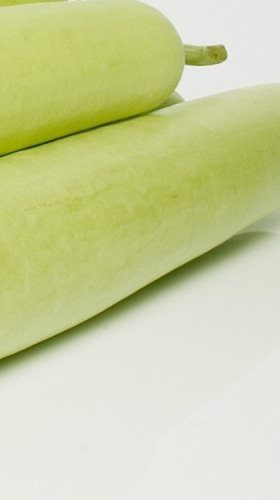Bottle Gourd Disease Management
Fusarium Wilt
Fusarium wilt and Gummy stem blight (GSB) are both soilborne fungal diseases that looks to cause similar symptoms in bottle gourds. Close observations for the signs and symptoms are required to differentiate for both the disease. Fusarium wilt is caused by Fusarium oxysporum [a pathogen that is classified into formae speciales (ff. spp.) based on strains that are adapted to specific hosts].
- The bottle gourd specific Fusarium oxysporum f. sp. Laginarae causes vascular wilt. A broad host rang Fusarium oxysporum f.sp. cucurbitacearum also causing wilt central part of India.
- Another Fusarium species, Fusarium solani f. sp. Cucurbitae also causes a crown and foot rot of bottle gourd.
- Sporadic incidence of preharvest and postharvest fruit rots of bottle gourds also caused by Fusarium solani.
- GSB is caused by Stagnoporopsis spp or Phoma spp and both have been frequently diagnosed in many parts of India.
Once a plant is infected, there is no treatment or cure. Therefore, management should focus on preventive and cultural control practices. Though Fusarium and GSB symptoms are predominantly similar, few symptoms are specific to the disease and discussed separately below.
Identification
In younger plants the Initial symptoms often include a dull, gray green appearance of leaves that precedes a loss of turgor pressure and progressive of wilting. In older plants (symptom appear after fruit set) the strong yellowing symptom starts in older leaves and progressive towards younger foliage and finally necrosis of whole plants. The primary diagnostic symptom of Fusarium wilt is a discoloration of the vascular system (xylem), which can be observed readily in longitudinal or cross section of roots or stems.
Favorable conditions
Fusarium wilts are generally most severe in light, sandy, slightly acidic soils when temperatures are between 25 and 27 C. Higher temperatures appear to impede infection often resulting in plants that are yellowed and stunted but not wilted. However, plants infected earlier in the season may display more severe symptoms later in the season, as the temperature increases, and there is more transpiration demand on the plant.
Disease transmission
Fusarium wilts are generally presumed to be monocyclic - that is, the disease does not exhibit plant-to-plant spread during the season. The pathogen can be spread within a field over a period of several seasons and from field to field. Spread within a field can occur by the movement of infested soil. Tillage practices, flooding or heavy rain, contaminated farm equipment, and other cultural or environmental factors may be involved. Field-to-field spread can occur when equipment and infected plants are moved from one field to another.
Management
A sequence of management plans must be initiated for disease control
- The primary inoculum source is organic debris from previous cucurbit crops. As soon as a cucurbit crop is harvested, the decaying debris from that crop should be disked and deep plowed into the soil if it is to be followed by a long-term crop rotation practice.
- Fields should not be cultivated with cucurbits routinely, and rotation with a non-cucurbit crop is important. A two- to three-year rotation with non-hosts is an effective way to reduce incidence of GSB.
- Seeds are primary source of inoculum and can be infested without expressing symptoms. Seed treatment is necessary to eliminate the seed contamination. So Purchase seeds from reputable companies like Nunhems with a good history of GSB-free seed production.
- Infected transplants can result in significant levels of disease developing in the field. So the grower should thoroughly inspect the seedling at nursery stage before transplanting. GSB is common at the seedling stage and displays one or more of the characteristic symptoms (necrotic areas on the margin of the leaves, water-soaked regions on the stem, gummy ooze from the stem). The symptoms can appear in 7–12 days after infection (spore germination). So it always recommend to drench the seedings with fungicide before transplanting. Pasting the stem collar region with appropriate fungicides will help to reduce the possibility of GSB infection form soil.
- As the fungus grows well in acidic soils, liming the soil is recommended. Avoid excessive nitrogen applications as overuse of nitrogen makes the tissue succulent increasing the risk of a fungal attack.
- Routine scouting of the fields helps in timely application of fungicides that can prevent major crop losses. Apply fungicides in a preventative manner.
- Grafting are used extensively in other cucurbits to control the soil borne wilts in different parts of the world. There are some bottle gourd varieties resistant to Fusarium were identified with non-desirable fruit qualities. So, this can be used as a root stock for bottle gourd grafting. However, grafting is labour intensive and costly.
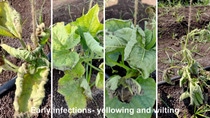
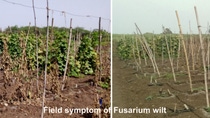
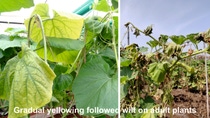
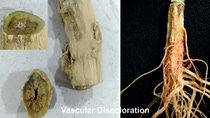
GSB Wilt
Fusarium wilt and Gummy stem blight (GSB) are both soilborne fungal diseases that looks to cause similar symptoms in bottle gourds. Close observations for the signs and symptoms are required to differentiate for both the disease. Fusarium wilt is caused by Fusarium oxysporum [a pathogen that is classified into formae speciales (ff. spp.) based on strains that are adapted to specific hosts].
- The bottle gourd specific Fusarium oxysporum f. sp. Laginarae causes vascular wilt. A broad host rang Fusarium oxysporum f.sp. cucurbitacearum also causing wilt central part of India.
- Another Fusarium species, Fusarium solani f. sp. Cucurbitae also causes a crown and foot rot of bottle gourd.
- Sporadic incidence of preharvest and postharvest fruit rots of bottle gourds also caused by Fusarium solani.
- GSB is caused by Stagnoporopsis spp or Phoma spp and both have been frequently diagnosed in many parts of India
Once a plant is infected, there is no treatment or cure. Therefore, management should focus on preventive and cultural control practices. Though Fusarium and GSB symptoms are predominantly similar, few symptoms are specific to the disease and discussed separately below.
Identification
This disease can occur early in seedlings and transplants, as well as anytime throughout the season. Infection signs and symptoms can see on all parts of the plant except roots. The young seedling produced chlorosis of leaf margin, light- to dark-brown necrotic cotyledonary leaves and brown lesion on the collar regions. At severe stage these seedling leads wilting followed by death. On older leaves the symptoms start as water-soaked lesions at the leaf margin and the lesion can extends towards the midrib to form a typical V shaped brown necrotic lesion with yellowish border.
In growing plants, the brown lesions can form on the stem that enlarge and girdle the main stem. Cracking is often visible on the stem that can be red, brown, or black in color and a red to amber gummy substance can exude from this region.
Anthracnose (caused by Colletotrichum orbiculare) and some abiotic stress like inadequate soil liming can also cause the exudation of a gummy substance from cucurbit stems; hence, "gummyness" should not be relied upon as a definitive diagnosis of GSB. A ‘pin head’ size black fruiting bodies of the fungus (pycnidia, perithecia, or pseudothecia) are often visible on the infected leaves, stems, and fruits. This can be easily observed by naked eyes without any hand lens and serve in confirmatory diagnosis.
Life Cycle/Favorable conditions
Moisture and temperature play an important role in germination, sporulation, colonization of conidia into the plant tissue, and symptom development. The optimum conditions for the infection process are temperatures ranging from 15°C–25°C and a moisture level of 85% RH caused by consistent leaf wetness for 4–10 hours. So when there is a high humidity and continuous moisture due to frequent rain, may expect the GSB infection. Wounding of lower leaf and or collar region of the stem by mechanical injury, feeding by striped cucumber beetles, and infections from other diseases may provide entry sites for the GSB pathogen. Harvest points on fruits can also be a point of entry for the pathogen, leading to postharvest decay.
Disease Transmission
The pathogen survives on surrounding weeds, or organic debris from previously infected cucurbits. Without a host, the pathogen is able to overwinter and survive for over a year as chlamydospores, hardened masses of hyphae that act as survival structures during dry or adverse conditions. The pathogen is transferred from infected hosts to healthy plants via ascospores carried in the wind and by conidia that are released from pycnidia by water splash and in gummy exude. They can survive for up to 2 years. Spread is by splashing water, wind-driven rain, and on fingers, knives and clothing during cultural operations. Development of the disease depends on how long the leaves, stems and fruits stay wet so that spores can germinate, infect, and for the fungus to continue to grow.
Management
A sequence of management plans must be initiated for disease control
- The primary inoculum source is organic debris from previous cucurbit crops. As soon as a cucurbit crop is harvested, the decaying debris from that crop should be disked and deep plowed into the soil if it is to be followed by a long-term crop rotation practice.
- Fields should not be cultivated with cucurbits routinely, and rotation with a non-cucurbit crop is important. A two- to three-year rotation with non-hosts is an effective way to reduce incidence of GSB.
- Seeds are primary source of inoculum and can be infested without expressing symptoms. Seed treatment is necessary to eliminate the seed contamination. So Purchase seeds from reputable companies like Nunhems with a good history of GSB-free seed production.
- Infected transplants can result in significant levels of disease developing in the field. So the grower should thoroughly inspect the seedling at nursery stage before transplanting. GSB is common at the seedling stage and displays one or more of the characteristic symptoms (necrotic areas on the margin of the leaves, water-soaked regions on the stem, gummy ooze from the stem). The symptoms can appear in 7–12 days after infection (spore germination). So it always recommend to drench the seedings with fungicide before transplanting. Pasting the stem collar region with appropriate fungicides will help to reduce the possibility of GSB infection form soil.
- As the fungus grows well in acidic soils, liming the soil is recommended. Avoid excessive nitrogen applications as overuse of nitrogen makes the tissue succulent increasing the risk of a fungal attack.
- Routine scouting of the fields helps in timely application of fungicides that can prevent major crop losses. Apply fungicides in a preventative manner.
- Grafting are used extensively in other cucurbits to control the soil borne wilts in different parts of the world. There are some bottle gourd varieties resistant to Fusarium were identified with non-desirable fruit qualities. So, this can be used as a root stock for bottle gourd grafting. However, grafting is labour intensive and costly.
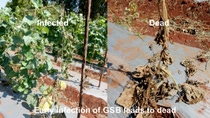

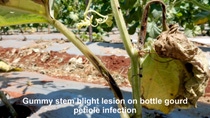
Powdery Mildew
Disease and Pathogen
Pathogen: Podosphaera xanthii
Powdery mildew is less common in bottle gourds compared with wilt and virus diseases. This disease is predominantly prevalent in the cooler spring and early summer months.
Identification
The fungi are an ectoparasite which produce mycelium that grows only on the surface of the plant tissues. Signs and symptoms are characterized by a white, talcum-like fungal growth on leaves, petioles, and stems. Fruits are rarely directly infected by powdery mildew. Symptoms first appear on the older lower leaves. Under favorable environmental conditions, fungal colonies can coalesce, and the host tissue becomes chlorotic, senescing prematurely. This disease is frequently more severe at the end of the vegetative cycle, causing additional losses by premature fruit ripening, shortening the length of harvest time, and affecting fruit quality as a result of premature defoliation and sunscald
Life Cycle/ Favorable Environmental conditions for the disease:
The fungi causing powdery mildews are obligate parasites which requires living hosts for the growth and multiplication. Initial inoculum spreads through winds blown from infected alternate weed hosts. Other major possible sources include over lapping of older crops in same or adjacent fields and ascospores stored in chasmothecia (overwintering structures, rarely found) on crop debris. Under favorable conditions, Powdery mildew develops rapidly; the time between infection and symptom expression can be as short as 3 days and many spores are produced. Conditions favoring infection include a dense plant canopy, low intensity light, high nitrogen fertilization, and high relative humidity (although infection can occur at relative humidity of less than 50%). Unlike other fungal pathogens, powdery mildews can survive and sporulate on host tissue without presence of free water. In contrast to most fungal spores, powdery mildew conidia are fully hydrated, and germination does not require uptake of exogenous water. Optimum temperatures for disease development are 20-25°C; infection can occur between 15-30°C. Temperatures of 37°C or above stop Powdery mildew development.
Disease Transmission:
Pathogen spores (conidia) can be transported with in or from field to field through air currents.
Management
Scout fields regularly (particularly lower leaf surfaces) and apply fungicides early in disease development. Thresholds are very low as Powdery mildew spreads rapidly and cannot be controlled once disease is well established.
- Weekly inspections are recommended especially after fruit set, when plants become more susceptible to powdery mildew disease.
- Adjusting planting dates to avoid conditions favorable to the pathogen.
- The use of resistant varieties is the simplest, effective, eco-compatible and economical means of controlling the disease. Powdery mildew is more likely to infect densely planted vines, plants crowded by weeds. So, choose planting sites with good air movement and free of shade.
- Unmanaged old crop can become a source of inoculum for new plantings; thus, it is important to remove all old crops actively. If it is not possible, separate the successive plantings physically to prevent older plants from serving as an inoculum source for new crop.
- Over fertilization make plants susceptible to powdery mildew. Follow proper nutrition management.
- Powdery mildew develops best on the lower leaf surfaces; thus, a successful fungicide program requires controlling the pathogen on both leaf surfaces. An important component of fungicide programs are materials which can move to the lower surface (systemic or translaminar).
- Fungal hyperparasite Ampelomyces Quisqualis (AQ10), Bacillus subtilis and its lipopeptide extracts reported the effective control of P. xanthii on cucurbits.
- Cucurbit powdery mildew control with oils and mineral salts in greenhouse experiments showed the pathogen to compromise on hyphal growth and conidial germinations.
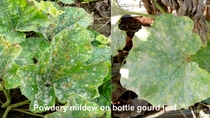
Virus Mosaic Disease
Disease and Pathogen
There are several common viruses that can affect bottle gourd, including Cucumber mosaic virus (CMV), Papaya ringspot virus-W type (PRSV-W), Zucchini yellow mosaic virus (ZYMV), Tomato leaf curl New Delhi virus (ToLCNDV). The Cucumber green mottle mosaic virus (CGMMV) also observed along with other virus species in northern India. Many of these viruses induce ‘Mosaic’ symptoms on leaves, the disease commonly known as mosaic disease. Except for CGMMV, which is seedborne and transmitted mechanically, the other major viruses are transmitted by several species of aphid (CMV, PRSV-W, ZYMV) and whitefly (ToLCNDV).
As the mixed infection is common phenomenon in bottle gourd and the symptom caused by each of the viruses are similar and often difficult to identify the virus species infected visually. Thus, for unambiguous virus detection and identification, laboratory methods are required.
There are no chemicals available to kill viruses. Chemical control of the insects that spread the viruses may minimize the disease. As most viruses are transmitted by aphids and whitefly in bottle gourd, the management should aim to delay infection and minimize the level of virus disease by controlling the aphids and whiteflies.
Identification:
- Aphids transmitted viruses (CMV, PRSV-W, ZYMV)- Mosaic symptom
The mosaic symptoms are most striking on new growth of young, rapidly growing plants. Leaves are pale green in color and/ or mottled with areas of light and dark green colour, dwarfed, misshapen, puckered. Many a time, the ZYMV produces a severe leaf distortion and blistering on leaves. Chlorotic ring spots on leaves observed for CGMMV infection. Fruit from virus-infected plants may be small, deformed, knobby and may develop unusual color patterns. The systemic infection of PRSV-W produces very severe blister on fruits and leads to non-marketable. Virus infection of older plants usually results in less dramatic symptom development and damage.
2. Whitefly transmitted viruses (TolCNDV)- Leaf curling symptom
ToLCNDV causes systemic infections on shoot tips of bottle gourd with discoloration, yellow mottling and vein banding followed by up- or down- ward curling. Chlorotic spots and mottling can be observed on older leaves. Early infections interferes with growth of vines by short inter node length and stunted growth. Fruits are small with unappealing discoloration, indents or blisters and may prematurely drop, which can eventually result in complete crop failure.
Life Cycle/ Favourable Environmental conditions for the disease:
Generally, aphids appear in November and remain active till April. Cloudy and moist weather favors rapid multiplication of the pest. As these viruses have a wide host range, can overwinter in perennial plants and weeds. If the post rainy season (Nov-Jan) is cool and wet, aphid numbers are decreased and virus spread is sporadic, with infected plants primarily located in rows bordering the edges of the field.
Disease Transmission:
This virus is transmitted by Aphids in a non-persistent manner (Stylet borne) and more than 80 aphids species associated with CMV transmission. Acquisition and transmission occur in very short time. The aphids cannot retain the virus for long time and have to acquire the virus repeatedly for the transmission to new plants. This virus is also mechanically transmitted. The Virus host plants can be a seasonal and perennial also. some may show clear symptoms while others are symptomless carriers.
ToLCNDV is transmitted by a tiny, sap-sucking insect which around 0.8mm in length and have a snow-white color in adult stage called whitefly (Bemisia tabaci). The dispersal of ToLCNDV is associated with the movement of the whitefly vector. Whiteflies seldom move locally from one to plant to another, and long-distance dispersal may be facilitated by winds and human activities. It is possible that whitefly populations move from one crop to another, particularly when a crop is harvested or abandoned.
Management
The greatest yield losses will occur in plants infected early in life. No single measure is likely to be effective alone and best results will be achieved from integrating options appropriate to the crop and farming system.
Before Planting:
- Select the suitable sowing windows, which can avoid periods of high aphids populations in the younger crops.
- Destroy weeds and volunteer cucurbits within and around crops as these harbors the viruses and/or aphids.
- Avoid over lapping old and new planting. Do not plant new crops next to the old cucurbit crops. This is very important if the “old” crop is infected with virus.
- Destroy harvested or abandoned cucurbit crops and crop debris as these are usually the major source of virus at the beginning and during the production period. If it is not possible to destroy, at lease separate the new crops from maturing one with green shade nets.
- Border crops: A 1meter strip around the field following a row crops (viz corn) with green shade net reduce the thrips movement. The row crops need to sow at least 2-3 weeks earlier than bottle gourd sowing.
- Planting into highly reflective plastic mulch which repel aphids and spraying refined mineral oils (stylet oil) can delay virus infection. Reflective mulch is most effective early before plants cover the rows. Mineral oil needs to be applied frequently (at least weekly) to protect the rapidly emerging new growth. Neither strategy is likely to be very effective if there is high virus pressure early in the crop cycle.
- Plant virus resistant or tolerant varieties if available.
During growth
- Apply row covers before crops emerge or to pest-free plants during planting. Plants are normally covered or caged only while they are young and most susceptible to damage. Once plants become larger or temperatures get warmer, remove covers to provide enough growing space and to prevent overheating. Drip or furrow irrigation is generally necessary when using row covers.
- Monitor routinely for aphids and whiteflies. Use yellow or blue sticky traps placed about 10 cm above the crop and inspect weekly.
Rogue any plants showing symptoms of virus to avoid the faster spreading.


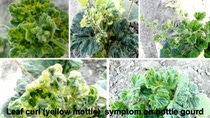%20%20symptom%20on%20bottle%20gourd.jpg)
